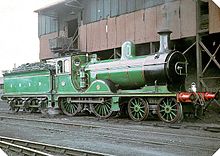Class V
In February 1898, the Scottish locomotive builder Neilson, Reid and Company had completed an order for twelve 4-4-0 locomotives for the Great North of Scotland Railway (GNSR); these comprised GNSR class T. [1] In October that year, William Pickersgill, the GNSR Locomotive Superintendent, requested authority to purchase a further twelve. Neilsons offered to build between ten and twenty further locomotives of the class T design. The GNSR Board of Directors granted permission for ten locomotives of a slightly modified design incorporating a side-window cab, and Neilson, Reid & Co. were awarded the contract that November (Neilsons order no. E827) at a price of £2,975 each. [2] [3] Delivery commenced in October 1899, but by the time that the first five locomotives had been received by the GNSR (class V; numbers 113–115, 25, 26), they found that a downturn in traffic meant that not only were the remaining five not required, but that they would also be unable to pay for them. Accordingly, the GNSR requested that Neilsons should find an alternative buyer, and to obtain the best possible price. They were duly sold to the South Eastern and Chatham Railway for £3,300 each, where they became that company's class G. [2] [3] An offer from the SECR to purchase the first five as well, but at £3,325 each, was turned down by the GNSR. [4]
A further eight locomotives (in two batches of four) to the same design as the 1899 batch were built by the GNSR at their Inverurie Works, Aberdeenshire, in 1909–10 (nos. 27, 29, 31, 36) and 1913–15 (nos. 28, 33, 35, 34). Once again, Pickersgill's recommended quantities were reduced: he had requested ten in 1903, and eight in 1911. [5]

